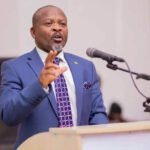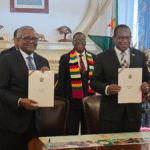In a strategic move towards ending decades of conflict in eastern Democratic Republic of Congo (DRC), the Southern African Development Community (SADC) and the East African Community (EAC) have joined forces. The two regional blocs convened a joint summit in Nairobi, Kenya, to launch a united peace initiative that leaders hope will bring long-overdue stability to the region.
The summit, co-chaired by SADC Chairperson President Emmerson Mnangagwa of Zimbabwe and EAC Chairperson President William Ruto of Kenya, marked the official appointment of a panel of five respected African statespersons tasked with steering the peace process.
The panel includes former Nigerian President Olusegun Obasanjo, former Kenyan President Uhuru Kenyatta, former Central African Republic President Catherine Samba-Panza, former Ethiopian President Sahle-Work Zewde, and former Botswana President Dr Mokgweetsi Masisi. These individuals were selected for their diplomatic experience and ability to navigate complex political situations.
During the Nairobi summit, leaders adopted the panel’s terms of reference and began discussing the funding structure for the mission. The setting may have been serene, punctuated only by birdsong and wildlife, but the tone among delegates was serious and focused.
President Mnangagwa described the occasion as a “clear demonstration of the two blocs’ collective resolve to resolve the eastern DRC conflict and to consolidate peace and security across the continent.”
He emphasised the importance of a regional and African-led approach. “Collaboration between your esteemed panel of facilitators, the African Union and the SADC and EAC regional blocs, is key in delivering a lasting solution to this conflict that has negatively impacted the lives and livelihoods of the people of eastern DRC for far too long,” Mnangagwa said.
He continued, “Allow me to underscore my readiness, and that of our two regional blocs, to constantly engage with you and facilitate your important work until peace and stability are realised in eastern DRC.”
Mnangagwa thanked the facilitators for accepting what he called an “onerous responsibility” to help bring peace to one of the most volatile regions on the continent. “Through your astute leadership, we remain hopeful that our two regions and indeed, the continent, will finally help to achieve peace, relief and reconciliation in the eastern DRC, with it, recovery and ultimately, sustainable development.”
He urged the panel to unlock bottlenecks and restore trust among all parties, saying, “We empathise with the daily struggles of our brothers and sisters in their cherished desire for enduring peace, security and development. We are, therefore, confident that as facilitators, your collective wisdom, expansive experience and leadership pedigree will be invaluable to the ensuing processes.”
The SADC Chair also called for an inclusive and comprehensive permanent ceasefire, describing it as a necessary step for delivering humanitarian support and creating the conditions for long-term peace. “As we implement the outcomes of the Joint EAC-SADC Summit, we are privileged to build on the strong foundations and gains achieved under the Nairobi and Luanda Peace Processes,” he said.
“This historic Joint EAC-SADC briefing provides a platform to have a shared understanding of the matters at hand and the enormity of the mission ahead,” Mnangagwa added.
He stressed that the success of the initiative would require support beyond the two regions, noting that collaboration with international bodies such as the United Nations and the African Union Commission would be vital. “The need for support and solidarity beyond our two regions is indisputable,” he said.
Although President William Ruto’s direct remarks from the meeting were not quoted in the original report, his role as co-chair of this unprecedented initiative signals a powerful commitment from East Africa to see an end to the unrest in eastern DRC. The partnership between Ruto and Mnangagwa represents a broader consensus that regional peace requires coordinated action and mutual responsibility.
For years, the eastern DRC has faced devastating violence, with numerous armed groups, political instability, and humanitarian emergencies displacing millions. Past peace efforts have made progress, but many have stalled due to fragmented approaches and limited regional alignment.
The newly appointed panel, backed by unified political will and regional leadership, offers a fresh opportunity to break that cycle.
Whether this initiative will finally bring peace remains to be seen. But for now, it is a bold and hopeful step, driven by African leadership, committed to African solutions.










